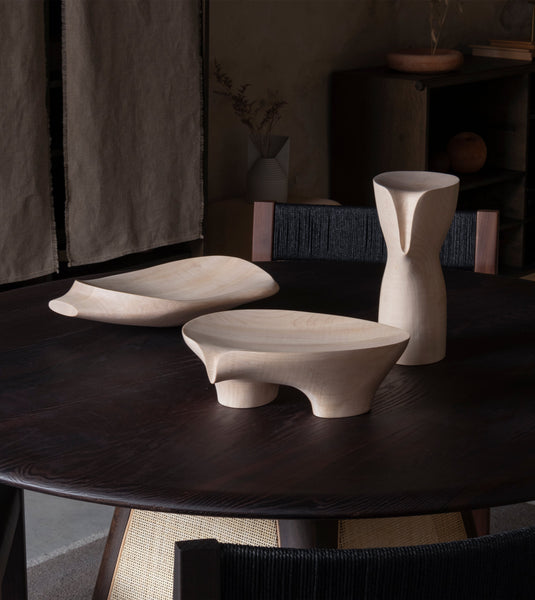Hand, Material, and Intuition: Interview with Théophile de Bascher
Lifestyle | Design Dialogues
Hand, Material, and Intuition: Interview with Théophile de Bascher

August 21, 2025
By: Miguel Pinto and Jason Khoo
We sit down with Théophile de Bascher, a sculptor-designer whose practice is rooted in a craft where chisel meets stone, and angle grinder strikes rock. Influenced by childhood memories of his father's lamp-making and driven by an almost meditative relationship with raw materials, this emerging talent navigates the compelling territory between sculpture and functional design.
Théophile's collaboration with Origin Made came about when Gabriel Tan, Origin Made's co-founder, saw his original hand-carved brick pebble sculpture series at Maison&Objet 2024. Intrigued by the story behind "Fracas", which Théophile transformed from fragments of brick architecture from Le Havre's old city, destroyed during World War II bombings and sculpted by over 80 years of tidal erosion into 'strange brick pebbles', Gabriel invited Théophile to have them translated into wood for Origin Made, resulting in the Drip Sculptures.
In this interview, Théophile shares insights into his material-first philosophy, the poetry he finds in imperfection, and how his background in direct stone carving continues to shape the objects that he creates.
Can you tell us a bit about your background and what drew you to design and sculpture?
My interest in design was born from a deep need to work with my hands. As a child, I watched my father make lamps, spending hours searching for the best way to assemble, transform, and reveal the beauty of pieces of wood that were often raw, marked, and carrying a history.
This very intuitive and sensitive approach to materials deeply influenced me. Little by little, I found in sculpture, particularly in direct stone carving, a natural extension of this fascination. The gesture, the tool, the material: everything is immediate, almost meditative.
What would you say are the fundamental principles or values that guide your work, regardless of the project or material used?
I believe that the poetry of an object comes first and foremost through the intimate connection it maintains with the material from which it originates. What touches me in nature are the dialogues between matter and the elements that transform it. These are the forms of erosion, tension, or adaptation that I try to transcribe in my pieces. Whether it's wood, stone, or another material, I need to go through physical contact, a gesture.


Photos by Stéphane Ruchaud
You seem to create forms that emerge more from intuition than rational reflection. How do you cultivate this more instinctive approach to design?
When I create an object, I like to lose myself in the curves, without necessarily thinking about its function. It is first about seeking formal harmony, then, in a second moment, imagining how this form could accommodate a function, for example, by hollowing out an opening to make it a vase, by drawing a flat surface to make it a pedestal table or table, or even a void to make it a centrepiece.
I cultivate this instinctive approach by confronting the material directly. A key moment was my encounter with stone. It's a noble, demanding material that forces you to be fully present. You repeat the same gestures, over and over, to make a form emerge that's more or less faithful to the initial idea. This provides a real sense of freedom, and it's often there that unexpected things arise.
The accidents, the variations in the material throughout the work, mean that the initial idea is never fixed. It evolves, transforms, sometimes to the point of completely departing from the starting intuition. It is precisely this freedom, this uncertainty, accompanied by a repetitive, almost ritual gesture, that opens me to a form of intuition. It is in this state that is simultaneously physical, mental, and sensible that my forms come to life.


Photos by Stéphane Ruchaud
After initially creating these brick pebble forms with your own hands, what was your experience transposing them into wood with another craftsman? Did this transformation reveal new dimensions in your creations? How do you manage the tension between your original vision and the new interpretations that emerge through collaboration with Origin Made?
I was very happy to see these pieces exist in another material, wood, and especially to discover how they would dialogue with each other. Originally, I had sculpted them separately in different materials.
The work with Origin Made involved a passage through 3D modelling, and this step allowed me to review the proportions, refine and modify certain details. For example, the spout of the two-footed piece didn't exist in the original version. It was in trying to create a coherent family between the three forms that this modification appeared as an obvious choice.
This back-and-forth between old pieces and a more current perspective stimulated me greatly. It wasn't about betraying the initial form, but adapting it.
Moving from unique brick-stone sculptures to small-series production makes your work, in a way, more accessible to a wider audience. Do you see this change as a dilution of your artistic expression or as an opportunity for your forms to inhabit more varied spaces and lives? How does this evolution challenge or enrich your conception of your work's role?
At first, I had this concern: by entering into a series logic, am I betraying something essential in my approach? Am I losing a form of freedom or singularity? I was also afraid of no longer being able to explore certain forms because they would be "frozen" in an edition.
But very quickly, I understood that Origin Made's vision was deeply respectful of the work of designers and craftsmen. Their way of valuing each step of the process reassured me. I didn't feel dispossessed of my objects, but on the contrary, supported them.
Finally, seeing my forms circulate, exist elsewhere, is also a way of giving them a second life. This allowed me to think of design as a natural extension of sculpture.

The Drip Sculptures function both as art objects and as containers that can hold personal effects. Was this dual function present from the start or did it emerge during the creative process?
It's precisely this ambiguity that I often seek to create. A function as simple as a container can take very different forms, and it's this blur between sculpture and functional object that interests me. For the Drip Sculptures, the idea came to me while observing pebbles on a beach, slowly emptying into each other. I wanted to translate this movement into another language of forms. These objects can be used, of course, but you can also simply look at them, touch them, and move them around. They impose nothing; they leave everyone free to project themselves onto them.
Your work seems to exist at the border between contemporary art and functional design. How do you navigate this boundary, and does it sometimes generate tensions in your creative process?
I consider myself first and foremost a sculptor, in the etymological sense: one who removes material to give birth to a form. But having been trained in object design, I still have trouble creating purely contemplative forms, totally freed from any function. I believe I'll truly become a sculptor the day I create a form that has no other purpose than its own presence. But for now, I still speak with the words of a designer. Artists like Isamu Noguchi inspire me greatly: he himself did design almost by accident. He realised that some of his works could become tables, seats, and places to inhabit. I believe that design, in this approach, is a way of giving practical meaning to an abstract form.
As a young designer/sculptor asserting your voice, how do you manage to stay true to your vision while composing with the realities of the design industry?
For me, the workshop is an essential space for experimentation. It's a laboratory where I can make mistakes, break things, start over, and attempt unexpected associations. It's there that I can preserve a form of absolute freedom, without constraints, and where I nourish my sculptor's practice. It's these instinctive researches that then allow me to shake up, even on a small scale, certain codes in design. I think staying true to your vision isn't about locking yourself into a style or method, but continuing to create from what deeply touches you, through simple gestures, inhabited forms.


Photos by Carlotta Rudari
How do you hope your work can influence or contribute to contemporary discussions around design, craftsmanship, and sustainability? Looking ahead to the coming years, how do you see the evolution of your practice? Are there materials, techniques, or concepts you wish to explore further?
I hope my work can reintroduce a form of slowness and attention in the relationship we maintain with objects. It often emerges from a gesture, from direct dialogue with the material. I believe this artisanal, almost archaic approach can today be perceived as an engaged gesture.
In an era when everything is accelerated, producing an object by hand, with its imperfections, its roughness, already tells another temporality. I don't seek to innovate technologically, but rather to delve into sensitive forms. If my work can nourish reflection on sustainability, it would be in the sense of more emotional design, and less interchangeable; design that weaves an intimate bond with the one who welcomes it.
In the coming years, I would really like to work with harder stones like marble or granite. I haven't had the opportunity yet, and these are materials that have attracted me for a long time. I'm eager to be able to create one or several pieces with these stones.



